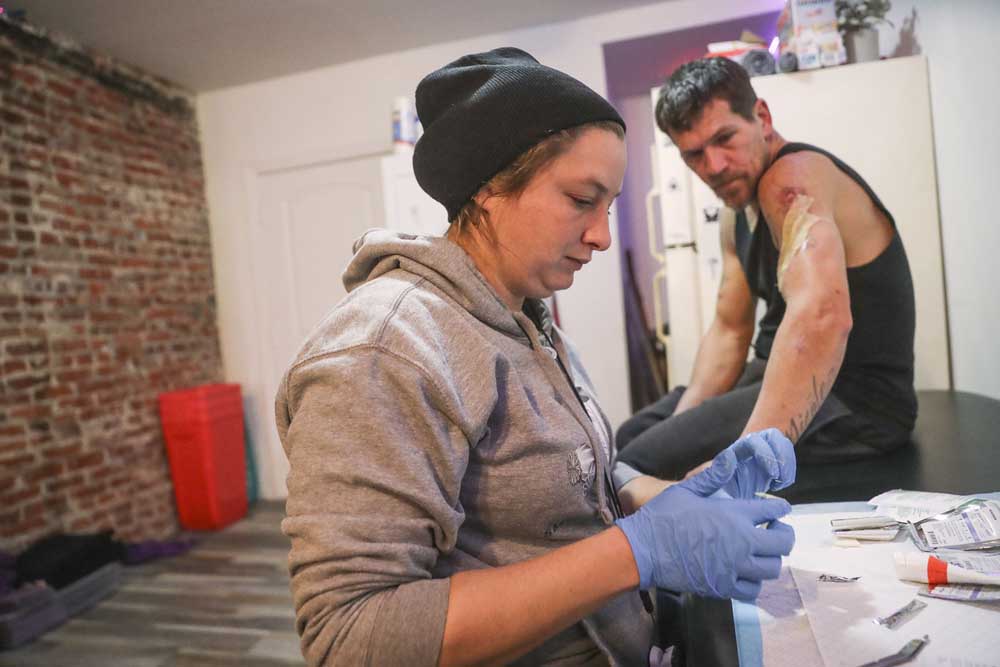Xylazine still ravaging Pennsylvania, and moving west
Published 3:03 pm Sunday, August 11, 2024

- Jen Shinefeld, a field epidemiologist, cleans the wound on the arm of Nick Gallagher at Savage Sisters, an outreach organization based in Kensington, in Philadelphia on Jan. 10, 2023. The staff at Savage Sisters help treat xylazine wounds and help people through withdrawal. (Heather Khalifa/The Philadelphia Inquirer/TNS)
It’s a drug that many throughout the Pennsylvania commonwealth are coming to know well: Xylazine, which has ravaged local communities for the past couple of years, leading to prolonged sedation, difficult revivals, worsened withdrawals and necrotic skin wounds.
And new data confirms that Pennsylvania remains a hot spot for the veterinary tranquilizer that has made its way into street drugs. Xylazine is also moving westward and leaving hordes of health care workers dumbfounded.
“Xylazine is increasingly becoming a national threat,” said Eric Dawson, vice president of clinical affairs at Millennium Health, leader of a new study about xylazine’s prevalence and patterns of movement throughout the country. “It is deeply entrenched in the East and heading West.”
One problem is that many providers who treat people using fentanyl and xylazine report not being taught about wound care, potentially compounding the severity of these sores and adding to a complex array of factors that hinder addiction medicine specialists and those who work in harm reduction from getting ahead of xylazine.
This is highlighted in a recent survey by University of Pittsburgh researchers, published in the Journal of Addiction Medicine last month, that laid out these results and called for updated and standardized wound care guidelines.
“We know across the country, there have been hot spots of xylazine in adulterants,” said Raagini Jawa, infectious disease and addiction medicine physician at UPMC, a doctor at Prevention Point’s wound care clinic and a leading xylazine expert. “These wounds heal, and they heal with basic wound care. If we catch them early, they heal very quickly.”
Although 99.8% of the 1,280 addiction providers surveyed reported seeing patients with xylazine-associated harms, less than half reported prior training in basic care for the wounds — and only 20% reported providing wound care on-site. Many others referred out to wound care specialists — a risk for an already vulnerable population that often faces lack of access to resources like transportation and housing.
“Here in Pennsylvania, this is something we need to think about critically,” said Dr. Jawa. “We have had xylazine in the supply for many years, and if wounds aren’t healing, that could also be because they’re not getting the proper care.”
The study only surveyed providers in the addiction medicine field, such as nurses, behavioral health staff, harm reduction workers and addiction medicine providers — the latter was the group in which the fewest number of people reported having basic wound care education, at 27% of providers saying they had been taught the skill compared to 62% of harm reductionists who provide street medicine.
“I went to medical school, and I probably had one class on wounds,” said Dr. Jawa. “I literally learned from harm reduction workers and nurses. This is not a skill we’re taught.”
The survey didn’t examine the experience of general providers.
“We have a long way to go, and we really need to ramp up our training and technical assistance,” she said.
While data last year from the Centers for Disease Control found that Pennsylvania was the leading state for xylazine in the country, new results confirm that.
Technicians from the San Diego-based Millennium Health, a third party clinical lab, tested more than 50,000 fentanyl-positive urine samples from all over the country. They discovered that Pennsylvania still leads the charge, with 40.3% of samples testing positive for xylazine.
On the ground, the picture becomes even more grim. Harm reduction workers at the nonprofit Savage Sisters, which often spends time doing outreach on Kensington Avenue in Philadelphia, has said based on its independent drug-checking efforts that 99% of the fentanyl supply is now adulterated with xylazine.
Dawson, of Millennium Health, said 60% of Pennsylvania samples for its study came from eastern Pennsylvania — specifically Philadelphia, Allentown and Scranton, with the remaining 40% coming from more western regions like Pittsburgh.
“Our data is a very good barometer of where xylazine is prevalent, but I do think it is likely undercounting the true sense of the problem,” he said. “(Xylazine) is deeply entrenched in the East and heading West. Fentanyl also started in the East. We’ve had a fear that xylazine would do the same, and indeed it appears that that is what is happening.”
A comparison of the second half of the study period (October 2023 to April 2024) to the first half (April 2023 to October 2023) illustrates this movement of xylazine westward. The Mountain region of the U.S. saw a 93.8% increase in xylazine positivity during the second half of the study period, and the Pacific region skyrocketed, with a 147% increase in positivity.
Percent change decreased throughout the eastern regions, despite Pennsylvania still holding the top spot for the presence of the tranquilizer.
Health agencies throughout the state are trying to combat this. On Aug. 2, Pennsylvania Department of Health Secretary Debra Bogen announced that the Shapiro Administration would distribute 50,000 wound care kits throughout the commonwealth. The kits will consist of protective equipment such as gloves and sanitizing wipes, wound dressings, sterile water, ointment, bandages and medical tape.
Dr. Bogen said in a news release that xylazine’s presence in Pennsylvania is “a major public health concern.” Some kits have already been distributed to more than 200 harm reduction and medical organizations throughout the state, per the release.
And Dr. Jawa has been compiling information to make fact sheets, hold presentations and give trainings to medical providers about the changing drug supply and xylazine’s consequences. She recently led a xylazine working group with UPMC staff to streamline how the institution broadly diagnoses and treats xylazine wounds. Staffers were present from varying specialties and helped create clinical protocols for the situation.
“We’re trying to fly the plane while we’re building it,” said Dr. Jawa. “We’re addressing these gaps at the same time we’re identifying them. Public health plans for the changing drug supply need to be multi-pronged. Unless we have a safe supply, drugs will continue to evolve.”
_____






